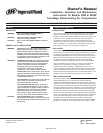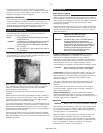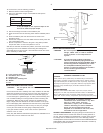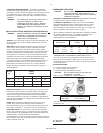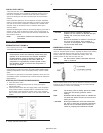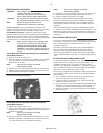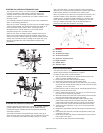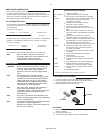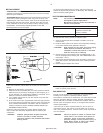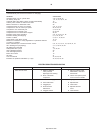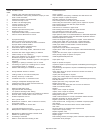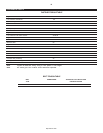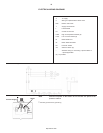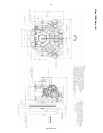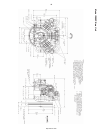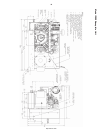
5
LOW OIL LEVEL SWITCH
A float activated low oil level switch may be installed to protect your
unit against damage due to insufficient compressor oil level. Low oil
level in the compressor crankcase causes the switch contacts to
open, thus shutting the unit down until the proper oil level has been
restored.
Proper protection against low oil level depends on proper adjustment
of the low oil level switch. During the initial run, stop the unit and drain
one quart of oil from the compressor crankcase into a suitable clean
container. Listen for the switch to click or check the switch with a
continuity tester.
The float sometimes gets cocked or stuck during shipping. If the float is
cocked or stuck, open the disconnect switch, drain the remaining oil,
remove the crankcase cover and then free the float. Reassemble and
then reuse the same oil.
NOTE If the float is cocked in the low position, the unit
cannot start.
OPERATION
INTERMITTENT DUTY FORMULA
Units operating above 200 PSIG are to be operated according to the
"Intermittent Duty Formula."
INTERMITTENT DUTY FORMULA
Pump-up time should not ordinarily exceed thirty (30)
minutes or be less than ten (10) minutes. Shutdown
periods between cycles of operation should be at
least equal to the pump-up time. Note: When the
compressor is regulated by constant speed control,
the shutdown period is the time the compressor is
operating unloaded.
A pump-up time limit with the following cool-down period is
recommended to protect the valves and heads against stabilized high
operating temperatures, which could rapidly build up carbon in these
areas.
All inquiries for high-pressure compressor application where the "use"
cycle differs from the "Intermittent Duty Formula" should be referred to
Ingersoll-Rand.
START-UP (ELECTRIC MOTOR DRIVEN MODLES)
1. Close the service valve.
2. Release any remaining tank pressure by slowly opening the
manual drain valve.
3. Close the manual drain valve and apply power to the compressor.
If the pressure switch is equipped with an “ON/AUTO-OFF” lever,
flip the switch to the “ON/AUTO” position. If the unit is equipped
with a control panel “ON/OFF” switch, move the switch to the “ON”
position.
Typical Pressure Switch
4. Slowly open the service valve.
Typical Service Valve (A = Open, B = Closed)
aCAUTION Unusual noise or vibration indicates a
problem. Do not continue to operate until you
identify and correct the source of the
problem.
NOTE Ensure the direction of rotation is correct per
the arrow on the motor. If the rotation is
incorrect on three-phase units, interchange
any two of the three leads.
COMPRESSOR CONTROLS
ADJUSTMENT PROCEDURE. Select either automatic start and stop
control or constant speed control by adjusting the knob on the auxiliary
valve. For automatic start and stop control, turn the knob on the
auxiliary valve fully clockwise to disable the auxiliary valve. The
pressure switch will then start and stop the unit.
NOTE For dual control models, automatic start and
stop is preferred.
Auxiliary Valve.
Select constant speed control if the unit restarts in less than 10 minute
intervals or runs more than 40 minutes per hour. Turn the knob fully
counterclockwise to run the unit continually.
NOTE The auxiliary valve is factory pre-set at 5 PSIG
lower than the factory pressure switch
setting.
NOTE Automatic Start & Stop Control is intended for
use when the motor will start no more than 6
times per hour.
aCAUTION Running unloaded for more than 20 minutes
per hour or more than 15 minutes continually
with the use of constant speed control will
cause oil pumping and should be avoided.
A
uxiliary Valve.
http://air.irco.com



